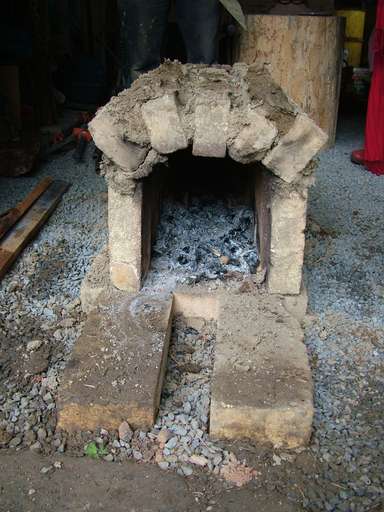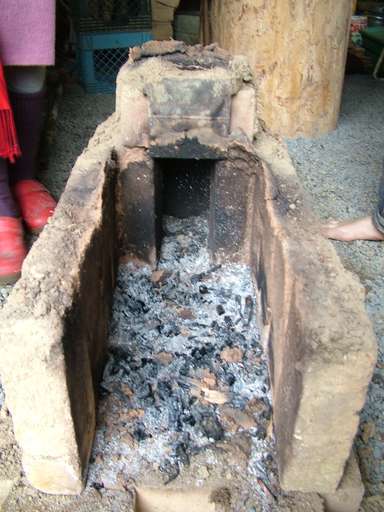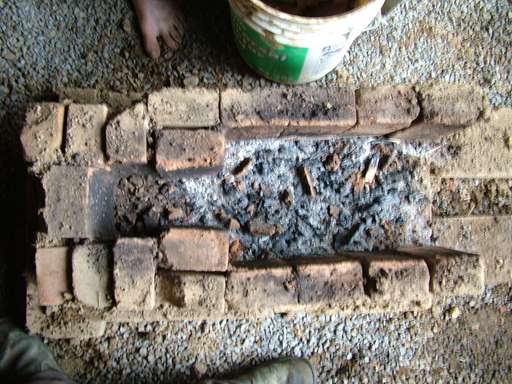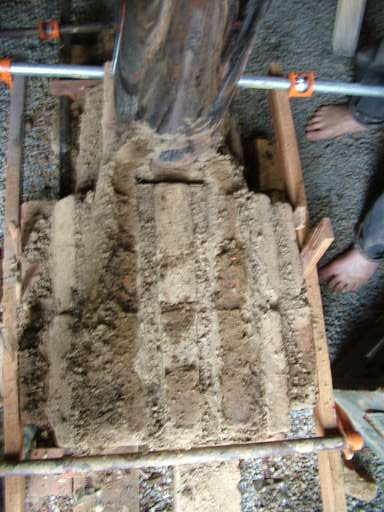|
|
Post by Donkey on May 1, 2012 8:02:53 GMT -8
Hey, all.. A few days ago, Canyon came to visit and he brought his ideas with him. ;D In my shop, we put together a six inch, horizontal feed test. We slapped it together with scrap-crap, brick and mud. It was NO candidate for a beauty pageant, but it SURE DID WORK! (grr.. Having trouble with the website, so I'll use the attachment feature  )  |
|
|
|
Post by Donkey on May 1, 2012 8:06:23 GMT -8
We photographed the stove as we took it apart. You can see that the chamber is larger than system size, with an arched top.  |
|
|
|
Post by Donkey on May 1, 2012 8:09:59 GMT -8
The key to the works is the air intake needs to be reduced to 1/4 system size and back at the throat, it returns to system size (or a little bit less) just before the heat riser. The brick at the top, (shown in the picture) drops down below arch height. Like Peterberg's rocket siphon. We used a trip wire brick there.  |
|
|
|
Post by Donkey on May 1, 2012 8:14:26 GMT -8
Believe it or not, we ALSO figured out that the Peter-Channel REALLY WORKS in this setup.. We placed it just in front of the brick I was talking about above.. The channel is sized for a "regulation" six inch system.
Canyon carved out two channels to draw air over the top of the arch (for pre-heating) and into the peter-channel, these channels were covered with brick and open to the front of the stove.
|
|
|
|
Post by Donkey on May 1, 2012 8:16:33 GMT -8
Here's the layout of the feed box bricks from above..  |
|
|
|
Post by Donkey on May 1, 2012 8:22:53 GMT -8
The peter-channel can be seen here between the arch bricks and the heat riser.  |
|
|
|
Post by Donkey on May 1, 2012 8:25:57 GMT -8
It looks to me like this design (with a little tweeking) makes the horizontal feed thing really work.
I'm impressed with it and will be fiddling with this idea more in the future.
I'll post more soon..
For now, gotta go.
|
|
|
|
Post by matthewwalker on May 1, 2012 21:33:07 GMT -8
Man, way cool. Looks like you guys had fun. So, is the idea to enable a larger firebox, to be able to load more wood?
|
|
|
|
Post by peterberg on May 2, 2012 8:38:21 GMT -8
It took a while to get my head around it, but now I see what has been done. It looks like the same principles as my rocket syphon, the new part is the implementation of the P-channel in this. It is leaning on the assumption that the majority of the combustible gases are in the top segment of the tunnel/firebox or whatever.
The surprising part is this: in spite of the primary air coming into the front side, this setup didn't smoke. The whole thing is inside the workshop, and that would be impossible with a smokey fire. Is this correct?
The firebox looks like 3 times as large as system size, the riser twice as long as the firebox. Am I right?
The next question will be: how will this new "thing" behave, completed with barrel and all? And you'll need a door of some sort.
This could be a next step towards a simple and very adequate rocket heater variant.
Edit:
Some more questions did spring to mind.
Is the "thing" loaded full as a batch-fed device?
Is it lit in front or close to the riser?
Are there results from canyon's analyzer?
How many minutes to smoke-less burning started from cold?
|
|
|
|
Post by Donkey on May 2, 2012 16:03:06 GMT -8
The riser was what we had laying about. It seemed over-tall to me and we spent no time experimenting with riser height.. Ideal riser height is still at question. We did load it as a batch feed. We lit a small fire, shoved it all the way to the front and loaded up behind. Peter, your rocket siphon is a large inspiration for this stove. I think an improvement would be to make the firebox floor into a V shape so that the wood is forced together as it burns. As it was, the fire would burn down and it would disarrange, not burning as cleanly as it could. We ran (started) the stove twice, the first time it took some time to get up to temperature and burn cleanly. The main issue was finding out how much air to allow, once the opening was set, it ran fine. Also, the first run started without the Peter-Channel. After some fiddling, we took the stove apart, added the channel, rebuilt it and stoked it up again at which time it took off so fast that flames shot out of the top of the riser. We had to screw some cement board to the shop ceiling to protect it. After a little time, we placed a small, 16 gallon barrel over the riser to protect the ceiling.. The next morning, we started the stove again to warm our hands before taking it apart. It was up to clean burning VERY quickly. I think the combination of the siphon, tripwire brick and channel are the winners here. Obviously, there is some work to be done on this design to perfect it, but I'm quite impressed with the promise it shows. Something like this will be relatively easy to build, provide a larger firebox for batch loading, allow for a glass door to see the fire, etc. Oh.. Peter, Canyon opened up the analyzer and took it out.. We oohed and ahhed over it for a bit, intended to use it and got so wrapped up in the new stove build and rebuild that we completely forgot to use the analizer..  |
|
|
|
Post by Donkey on May 3, 2012 7:34:30 GMT -8
Peter..
I forgot to say that the workshop has no doors or windows. The shop is currently WIDE open, I plan to close it in this year, add doors and windows.. During the summer months our forest is a tinderbox, it's not a question of IF someday it will all burn but WHEN. I don't want to be the guy that sets it all to light, so It's a non-flammable, cob metalshop. A safe place to put the forge and welding rig.
During the first burn, we smoked the place up pretty well getting the stove started and figuring out the air size, etc. It was raining so we needed a place out of the rain and the shop was it.
(edit) once we got the air right and the P-channel in, it stopped smoking. The second run did not smoke at all.
|
|
|
|
Post by Donkey on May 3, 2012 9:53:34 GMT -8
Here is a Sketchup file of our brick layout. Our arch was NOT as high as what is shown in the .skp file.. Also, when I made this file, I didn't bother to get the size of the Peter-Channel or the tripwire brick correct. Really, this is only to show the layout of the parts more clearly than our images provide.
|
|
|
|
Post by Donkey on May 4, 2012 11:07:25 GMT -8
Umm.. I checked the size of the P-plate against the sketchup model.. It's actually pretty accurate. The difference being that in the model, the plate has no thickness. Also, the position of the plate in the model is a little off. If you hide the arch groups, you will see that the plate inter-penetrates the bricks below. Clearly, it ain't that way in reality. The arch bricks needed to be cheated forward slightly to accept the plate. When we did that in reality, we collapsed the arches and so the quick rebuild.  |
|
|
|
Post by peterberg on May 4, 2012 11:23:59 GMT -8
OK then...
Thanks for the drawing, this is quite clear. The firebox is remarkable large for a first iteration, something between 4 and 5 times system size.
Lately, I've come to the conclusion a lot of the ballast gases (the 79% of air that doesn't contribute to combustion) pass through at the bottom of the siphon or burn tunnel, while the combustible gases like CO and tars are at the top. The opening has to have some height also, a narrow horizontal slit won't work, I've tried that before. Following that assumption, the only thing that need to be done is adding some air at the top. That could be the main reason why the P-channel is so effective.
Looking at your drawing, having the opening from firebox to riser vertical instead of horizontal would also be right in this respect. With the siphon opening horizontal, there's a stiff chance some unburned stuff could escape through when not the whole width is filled with flames.
I'd need to build a test bed this summer and let the Testo have a sniff at it. Too bad you both forgot about the analyzer, but there have been made some choices which make sense theoretically. This has been time well spent, gentlemen!
|
|
|
|
Post by Donkey on May 4, 2012 13:17:55 GMT -8
Hmm.. So, in light of your "tile shaped roof", that would make sense. Burnables will be forced up into the narrow shape, where they would be more likely to contact flame.
One conversation that Canyon and I had.. Metal heat risers burn out. Metal can only burn if there's enough oxygen left over to do the job. Is there some way to reduce or exclude excess oxy (and other ballast gases)?? I know that is the intent of the Russian bell stove builder with his narrow slot at the bottom of the burn area. You and I have spoken about this in the past, you seemed to say that it makes no difference.. I still wonder if a way can be found to shunt that stuff out of the system.. ??
|
|